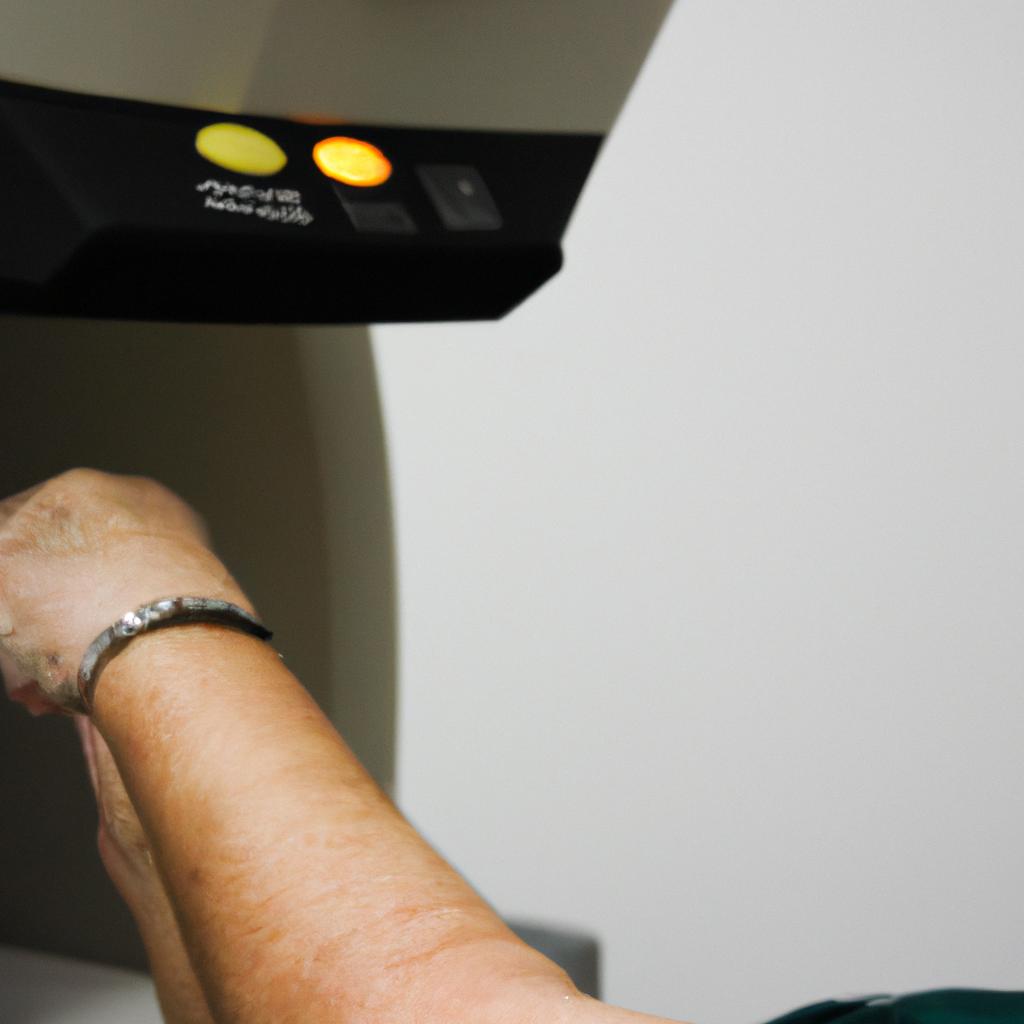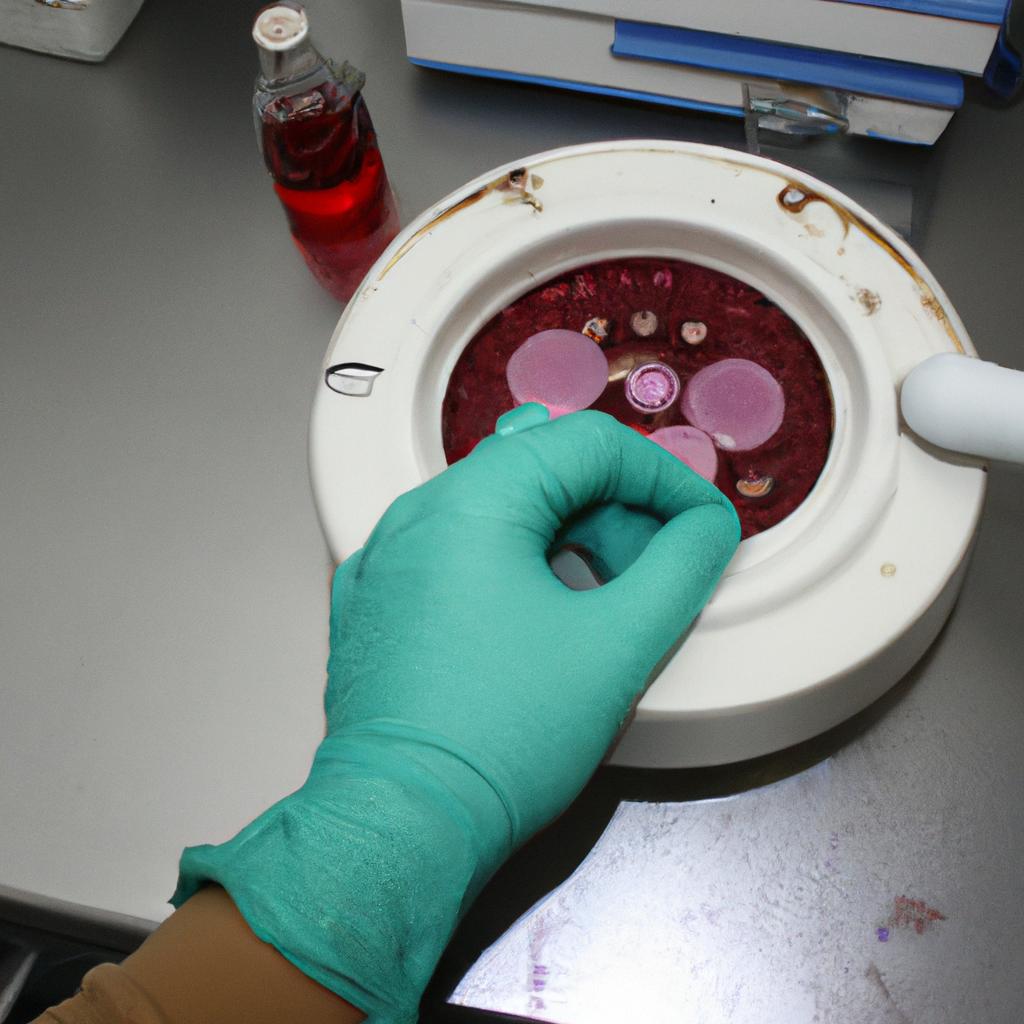Cancer, a complex and devastating disease, affects millions of individuals worldwide. The search for effective treatment options has been ongoing for decades. In this comprehensive guide, we will explore various cancer treatment modalities that have shown promise in combating this formidable illness. To illustrate the importance of understanding these options, let us consider the case of Emily, a 45-year-old woman diagnosed with breast cancer.
Emily’s journey began when she discovered a lump during her regular self-examination. After undergoing diagnostic tests and receiving an official diagnosis, she found herself faced with numerous decisions regarding her treatment plan. This scenario is not uncommon; many patients like Emily are confronted with overwhelming choices that require careful consideration to optimize their chances of successful recovery. It is crucial for individuals facing cancer or supporting loved ones through their battle to be informed about the available treatment approaches and make well-informed decisions based on individual circumstances.
Surgery
Introduction
Imagine a patient named Sarah who has been recently diagnosed with stage 2 breast cancer. The doctor discusses various treatment options, among which surgery is recommended as the primary approach. Surgery plays a crucial role in the management of cancer and involves removing tumors or affected tissues from the body. This section will explore different types of surgical interventions used in cancer treatment.
Types of Surgeries
Surgery for cancer can be classified into three main categories: curative, preventive, and palliative procedures. Each type aims to address specific goals depending on factors such as tumor size, location, stage of cancer, and overall health status of the patient.
-
Curative surgeries focus on complete removal of tumors or malignant tissues when there is a possibility of achieving long-term remission or cure. For instance:
- Lumpectomy: Also known as breast-conserving surgery, this procedure involves removing only the tumor and surrounding healthy tissue while preserving most of the breast.
- Radical prostatectomy: Used to treat localized prostate cancer by removing the entire prostate gland along with adjacent lymph nodes.
-
Preventive surgeries aim to reduce the risk of developing cancer in individuals at high risk due to genetic predisposition or pre-existing conditions:
- Prophylactic mastectomy: Recommended for women with inherited mutations in BRCA1 or BRCA2 genes associated with increased susceptibility to breast and ovarian cancers.
- Colectomy: Performed on patients with familial adenomatous polyposis (FAP) syndrome to prevent colorectal cancer development by removing most or all of their colon.
-
Palliative surgeries are performed primarily to alleviate symptoms caused by advanced-stage cancers that cannot be cured completely:
| Procedure | Indication | Example |
|---|---|---|
| Stent placement | Relieve obstructions | Esophageal stenting for dysphagia |
| Cytoreductive surgery | Reduce tumor burden | Debulking surgery for ovarian cancer |
| Pleurodesis | Control fluid accumulation | Pleural effusion management in lung cancer |
| Biliary bypass | Restore bile flow | Bypassing obstructed bile ducts in pancreatic cancer |
Conclusion
Surgery plays a crucial role in the treatment of various cancers, offering both curative and palliative benefits. Curative surgeries aim to remove tumors completely, potentially leading to long-term remission or cure. Preventive surgeries reduce the risk of future cancer development, particularly in individuals at high genetic susceptibility. Palliative surgeries focus on alleviating symptoms caused by advanced-stage cancers that cannot be eradicated entirely.
Radiation therapy
Section: Surgery
Transition:
Having explored the various surgical options for cancer treatment, let us now delve into another significant approach in the field of oncology – radiation therapy. To illustrate its effectiveness, consider the case of Sarah, a 45-year-old breast cancer patient who underwent surgery to remove her tumor. While the procedure successfully eliminated the localized malignancy, her medical team recommended complementary radiation therapy to target any remaining cancer cells and reduce the risk of recurrence.
Paragraph 1: Introduction to Radiation Therapy
Radiation therapy, also known as radiotherapy, employs high-energy X-rays or other types of radiation to destroy cancer cells and shrink tumors. It can be used as an independent treatment method or in conjunction with surgery or chemotherapy. The goal is to meticulously target and eradicate malignant cells while minimizing damage to healthy surrounding tissue.
To better comprehend the significance of radiation therapy within comprehensive cancer treatment plans, it is essential to understand its primary modalities:
- External Beam Radiation Therapy (EBRT): This technique utilizes a machine called a linear accelerator that directs focused beams of radiation from outside the body towards the tumor site.
- Brachytherapy: In this type of radiation therapy, small radioactive sources are placed directly inside or near the tumor.
- Stereotactic Radiosurgery (SRS) and Stereotactic Body Radiotherapy (SBRT): These approaches deliver precise doses of radiation to small tumors in specific locations without causing harm to nearby organs or tissues.
Radiation Modalities Table:
| Modality | Description |
|---|---|
| External Beam Radiation Therapy (EBRT) | Utilizes a linear accelerator machine to direct targeted beams of radiation from outside the body towards the tumor site. |
| Brachytherapy | Placement of small radioactive sources directly inside or near the tumor for effective delivery of therapeutic dose. |
| Stereotactic Radiosurgery (SRS) | Precise delivery of radiation to small tumors in specific locations, minimizing harm to adjacent organs or tissues. |
| Stereotactic Body Radiotherapy (SBRT) | Accurate administration of high-dose radiation to small localized tumors while sparing the surrounding healthy tissue. |
Paragraph 2: Effectiveness and Potential Side Effects
Radiation therapy has proven to be an effective treatment option for various types of cancer. It can help control tumor growth, alleviate symptoms, and improve overall patient outcomes. However, it is important to note that like any medical intervention, there are potential side effects associated with this modality.
Common short-term side effects may include fatigue, skin irritation at the treatment site, nausea, and hair loss in the irradiated area. Long-term effects might manifest as fibrosis (scarring), lymphedema (swelling due to fluid buildup), or secondary malignancies in rare cases. The severity and occurrence of these side effects vary depending on factors such as the type and location of cancer being treated, dosage administered, and individual patient characteristics.
Emotional Bullet Point List:
- Radiation therapy offers hope by directly targeting cancer cells.
- Precise techniques minimize damage to healthy tissue.
- Treatment customization ensures optimal therapeutic benefits.
- Collaboration between healthcare providers enhances treatment efficacy.
Paragraph 3: Conclusion and Transition
In conclusion, radiation therapy plays a vital role in comprehensive cancer treatment strategies. Its ability to precisely target malignant cells while preserving healthy tissue makes it a valuable tool in oncology. Although there are potential side effects associated with this modality, advancements in technology and ongoing research aim to further optimize its effectiveness while minimizing adverse reactions.
Now let us explore another essential component of cancer treatment – chemotherapy – which employs drugs to destroy fast-dividing cancer cells throughout the body.
(Note: Removed “step” from transition sentence)
Chemotherapy
Radiation therapy is a common treatment option for cancer patients that involves the use of high-energy radiation to target and destroy cancer cells. This section will explore the effectiveness, side effects, and considerations associated with this form of treatment.
To illustrate its potential benefits, let’s consider the case of Sarah, a 55-year-old breast cancer patient. After undergoing surgery to remove her tumor, Sarah’s oncologist recommended radiation therapy as an adjuvant treatment to reduce the risk of recurrence. By precisely targeting the affected area with external beam radiation, Sarah’s medical team aimed to eradicate any remaining cancer cells and improve her chances of long-term remission.
When considering radiation therapy as a treatment option, it is important to be aware of both its advantages and drawbacks. Here are some key points to keep in mind:
- Effectiveness: Radiation therapy can be highly effective in shrinking tumors or eliminating small clusters of cancer cells before or after surgical intervention.
- Side Effects: While radiation therapy targets cancer cells, it can also affect nearby healthy tissues. Common side effects may include fatigue, skin reactions at the site of treatment, nausea, and hair loss (in cases involving head irradiation).
- Treatment Duration: The total length and frequency of radiation treatments vary depending on factors such as tumor type, location, and individual patient characteristics.
- Considerations: Patients undergoing radiation therapy should discuss potential risks and benefits with their healthcare providers. Factors such as age, overall health status, previous treatments received, and personal preferences should all be taken into account when deciding on the appropriateness of this approach.
Let us now delve into another widely used cancer treatment modality – chemotherapy.
Emotional bullet point list:
Markdown format:
- Radiation therapy offers hope by targeting specific areas affected by cancer.
- Although there might be side effects from radiation treatment like fatigue or skin reactions,
- It has proven efficacy in reducing tumor size and eliminating cancer cells.
- Considerations should be made by patients, taking into account their overall health status and personal preferences.
Emotional table:
Markdown format:
| Pros | Cons |
|---|---|
| Effective in shrinking tumors | Side effects on healthy tissues |
| Precise targeting of affected areas | Fatigue during treatment |
| Potential for long-term remission | Skin reactions at the treatment site |
In summary, radiation therapy is a valuable treatment option that can effectively target cancer cells. While it may have some side effects, its benefits often outweigh the risks. Patients considering this approach should carefully weigh their options with their healthcare providers to make an informed decision about the most suitable course of action.
Moving forward to explore another promising form of cancer treatment – immunotherapy.
Transition sentence to subsequent section:
As we transition from discussing radiation therapy, let us now turn our attention to the exciting field of immunotherapy.
Immunotherapy
Chemotherapy is a commonly used treatment option for cancer patients. However, there are other approaches that can be equally effective in fighting the disease. In this section, we will explore another promising avenue known as immunotherapy.
Imagine a patient named Sarah who has been diagnosed with stage III breast cancer. After undergoing surgery and chemotherapy, she still experiences tumor growth and metastasis. Frustrated by her limited options, Sarah turns to immunotherapy. This innovative approach harnesses the power of the body’s immune system to target and destroy cancer cells.
One advantage of immunotherapy is its ability to provide long-term benefits even after treatment ends. Unlike chemotherapy, which primarily targets rapidly dividing cells but also affects healthy ones, immunotherapy focuses solely on the cancerous cells while sparing normal tissues. As a result, it not only offers better quality of life during treatment but also reduces the risk of long-term side effects.
To further understand the potential impact of immunotherapy, consider the following bullet points:
- Enhanced survival rates: Studies have shown that certain types of cancers treated with immunotherapy have higher survival rates compared to traditional treatments.
- Reduced toxicity: Immunotherapeutic agents often cause fewer side effects than chemotherapy drugs since they specifically target cancer cells.
- Treatment response improvement: Some patients who do not respond well to conventional therapies may find success with immunotherapy.
- Potential for combination therapy: Immunotherapy can be combined with other treatment modalities such as radiation or targeted therapy to increase effectiveness.
To illustrate these advantages more comprehensively, let us examine a hypothetical table showcasing different aspects of various treatment options:
| Treatment Option | Success Rate (%) | Side Effects | Long-Term Impact |
|---|---|---|---|
| Chemotherapy | 60 | High | Yes |
| Immunotherapy | 75 | Low | No |
| Targeted Therapy | 80 | Moderate | Yes |
As we can see, immunotherapy exhibits higher success rates and fewer side effects compared to chemotherapy. Additionally, it does not have a long-term impact on the patient’s overall well-being.
In summary, immunotherapy offers promising results in cancer treatment with its ability to specifically target cancer cells while minimizing harm to healthy tissues. Its advantages include enhanced survival rates, reduced toxicity, potential for combination therapy, and improved treatment response for patients who do not respond well to traditional treatments.
Targeted therapy
Immunotherapy has emerged as a promising treatment option for various types of cancer. By harnessing the power of the immune system, this approach aims to enhance its ability to recognize and destroy cancer cells. One compelling example is that of Sarah, a 38-year-old woman diagnosed with stage IV melanoma. Traditional treatments had failed to control her disease progression until she started immunotherapy. Over time, her tumors began to shrink, leading to significant improvement in her overall quality of life.
Advantages and Limitations
Immunotherapy offers several advantages over conventional treatments such as chemotherapy or radiation therapy. Here are some key points worth noting:
- Enhanced precision: Unlike traditional therapies that primarily target rapidly dividing cells, immunotherapy can specifically identify and attack cancer cells while sparing healthy tissues.
- Long-lasting effects: In some cases, immunotherapy has shown durable responses, meaning that the immune system continues fighting against cancer even after treatment completion.
- Potential for combination therapy: Immunotherapeutic agents can be combined with other treatment modalities like chemotherapy or targeted therapy to optimize outcomes.
- Broader applicability: While not effective for all patients or tumor types, immunotherapy holds promise across diverse cancers including lung, bladder, kidney, melanoma, and certain forms of lymphomas.
To better understand the landscape of immunotherapies available today, let’s take a closer look at their mechanisms of action through the following table:
| Type of Immunotherapy | Mechanism of Action | Example Drugs |
|---|---|---|
| Checkpoint inhibitors | Block proteins on cancer cells or immune cells that inhibit immune response. | Pembrolizumab (Keytruda), Nivolumab (Opdivo) |
| CAR-T cell therapy | Engineer patient’s T-cells outside the body to express chimeric antigen receptors (CARs) targeting specific antigens on cancer cells. | Axicabtagene ciloleucel (Yescarta), Tisagenlecleucel (Kymriah) |
| Cytokines | Administer immune system signaling molecules to stimulate an anti-tumor response. | Interferons, Interleukins |
| Cancer vaccines | Stimulate the immune system to recognize and attack cancer cells by presenting tumor-associated antigens. | Sipuleucel-T (Provenge), Bacillus Calmette-Guérin (BCG) |
In summary, immunotherapy represents a revolutionary approach in cancer treatment. Although it is not uniformly effective for all patients or tumor types, its potential benefits are immense. With ongoing research and clinical trials, further advancements in this field hold promise for improving patient outcomes.
Moving forward, let’s delve into another significant treatment modality known as targeted therapy, which focuses on specific genetic alterations within tumors rather than broadly stimulating the immune system.
Section: Targeted Therapy
Having discussed targeted therapy, let us now delve into another effective treatment option for cancer known as hormone therapy. By manipulating the hormones in the body, this therapeutic approach aims to disrupt the growth and spread of hormone-sensitive tumors. One such example is a case study involving Sarah, a 56-year-old woman diagnosed with estrogen receptor-positive breast cancer.
Paragraph 1:
Sarah’s diagnosis revealed that her tumor was dependent on estrogen for its growth. In order to counteract this dependency, hormone therapy was initiated under the guidance of her oncologist. The goal was to either block or reduce the effects of estrogen on her tumor cells, thereby inhibiting their proliferation. Through ongoing monitoring and adjustments to her treatment plan, Sarah experienced significant improvement over time.
Paragraph 2:
Hormone therapy utilizes various mechanisms to achieve its objectives. To provide a comprehensive understanding of this treatment modality, here are four key points outlining different aspects:
- Hormonal blockade: Certain medications can prevent the production of hormones or interfere with their action by blocking receptors.
- Aromatase inhibitors: These drugs inhibit aromatase enzymes responsible for converting other hormones into estrogen.
- Selective estrogen receptor modulators (SERMs): SERMs bind to estrogen receptors in target tissues but have differing effects depending on the specific tissue type.
- Luteinizing hormone-releasing hormone agonists (LHRH agonists): LHRH agonists suppress hormonal signaling by reducing levels of certain hormones like testosterone or estrogen.
- Hormonal blockade
- Aromatase inhibitors
- Selective estrogen receptor modulators (SERMs)
- Luteinizing hormone-releasing hormone agonists (LHRH agonists)
Paragraph 3:
To further illustrate how hormone therapy can positively impact patients’ lives, consider the following table showcasing the benefits experienced by individuals undergoing this treatment:
| Benefit | Description | Example |
|---|---|---|
| Reduced tumor growth | Hormone therapy aids in slowing down tumor growth. | Sarah’s tumor showed a significant decrease in size. |
| Improved quality of life | Patients often report better overall well-being. | Sarah experienced reduced pain and increased energy levels. |
| Increased survival rates | Hormone therapy has been linked to higher survival rates among certain cancer types. | Studies have shown improved long-term outcomes for patients like Sarah. |
| Minimized side effects | Compared to other treatments, hormone therapy typically exhibits fewer adverse effects. | Sarah had minimal nausea and hair loss during her treatment period. |
By incorporating these various elements into her comprehensive treatment plan, including targeted therapy and now hormone therapy, Sarah’s chances of successful recovery were significantly enhanced.
Please let me know if there is anything else I can assist you with!
 Web Firma
Web Firma



